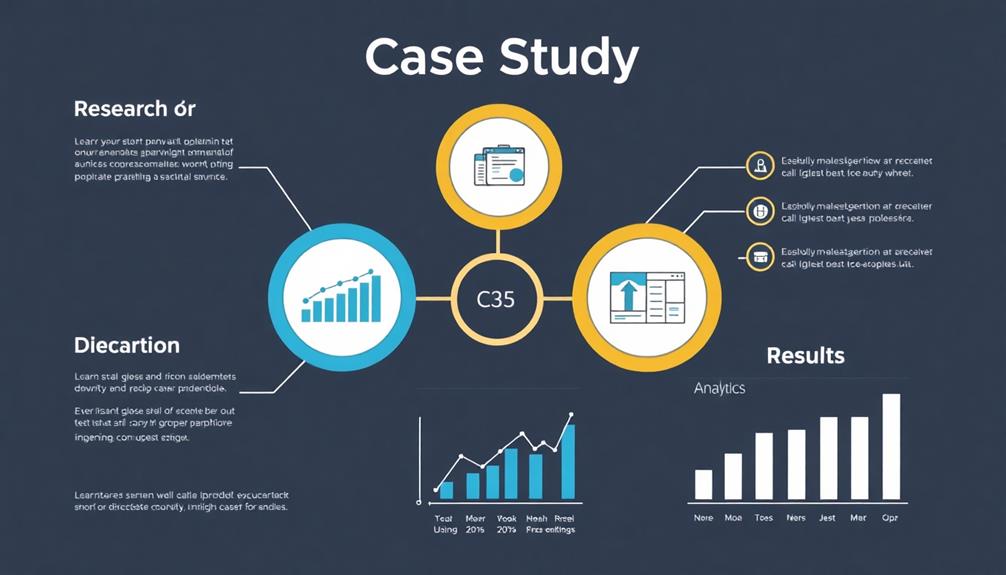To craft a winning case study, you need to focus on several key elements. Start with a compelling title that highlights results. Next, simplify your content for clarity; this retains attention. Authentic storytelling is essential—real experiences resonate best. Choose an engaging medium, like videos or infographics, to showcase data effectively. Structure your case study with a concise executive summary, challenges, and actionable solutions. Don't forget to promote it across multiple channels and optimize for search visibility. These strategies aren't just tips; they could transform your case studies into powerful marketing tools. Discover more insights on this topic.
Key Takeaways
- Start with an attention-grabbing title that highlights key metrics to pique interest immediately.
- Provide a concise executive summary, outlining the client and context in 3-5 sentences.
- Clearly define primary and secondary challenges to set the framework for the case study.
- Detail specific strategies implemented, focusing on actions taken to address the challenges.
- Present measurable results with quantitative data to demonstrate the impact of the solutions provided.
Importance of Permission

When it comes to case studies, obtaining permission from your customers is vital. Customer consent isn't just a courtesy; it's a legal necessity that guarantees you're respecting their privacy and complying with any legal agreements, like NDAs.
In sensitive areas such as discussing end-of-life care preferences, understanding and honoring privacy can greatly impact trust. Without this consent, you risk violating trust and potentially facing legal repercussions.
Navigating legal considerations is important in this process. You need to be aware of data usage agreements that dictate how you can use your customer's information. Ignoring these can lead to disputes that could harm your relationship with your client, as well as your reputation.
To streamline the permission process, consider following a structured approach, like HubSpot's eight-step guide. This guide can help you effectively gain the necessary permissions while making your clients feel comfortable.
It's also important to coordinate on visuals to guarantee brand alignment and that everyone's on the same page regarding how their image will be represented.
Simplifying the Content

When you simplify your content, clarity becomes your top priority. Use short sentences and clean layouts to keep your readers engaged and make the information easy to digest.
Regular maintenance and filter replacement guidelines can also enhance clarity in your presentation by ensuring all information is accurate and relevant.
Clarity Over Complexity
Prioritizing clarity in your case studies transforms complex information into digestible insights. When you focus on clear writing, you enhance readability for diverse audiences, making the results more impactful. Start by simplifying your design—avoid crammed layouts and excessive text to maintain focus on key messages. Highlighting important data upfront allows readers to grasp the main outcomes quickly.
Here's a simple table to illustrate the key elements of clarity in case studies:
| Element | Importance | Impact |
|---|---|---|
| Simple Language | Eliminates jargon | Broadens audience reach |
| Clean Layout | Maintains focus | Improves narrative flow |
| Highlight Key Data | Enables quick understanding | Saves reader's time |
| Short Paragraphs | Enhances readability | Keeps readers engaged |
Short Sentences Matter
Clear writing sets the stage for effective communication in case studies, but it's the use of short sentences that truly enhances comprehension.
When you use concise language, your readers can grasp ideas more quickly. This is especially important in today's fast-paced world, where attention spans are short, and social media dominates.
Here are four reasons why short sentences and paragraphs matter:
- Improved Readability: Short sentences break down complex ideas. Readers can easily follow your narrative without feeling overwhelmed.
- Quick Insights: Present key data upfront. This helps readers grasp critical insights without sifting through dense text.
- Engaging Content: A simplified design with short paragraphs prevents crammed visuals. It creates a more fluid reading experience.
- Broader Accessibility: Using straightforward language eliminates jargon. This guarantees your content appeals to a wider audience.
Visual Appeal Counts
Visual appeal plays a crucial role in simplifying content and enhancing reader engagement. When crafting the anatomy of a great case study, you shouldn't underestimate the power of an uncluttered design. A crammed layout filled with excessive text can overwhelm your audience, making it hard for them to absorb the essential information.
Instead, focus on a clean layout where highlighted data stands out, allowing key metrics to make an immediate impact. Incorporating elements from unique planter designs can serve as a reminder of how artistic presentation can elevate content appeal.
Take inspiration from IDEO's urban farming case study, which effectively showcases how a well-structured design improves narrative flow and reader comprehension. Use succinct sentences and short paragraphs, prioritizing clarity over jargon, to facilitate understanding.
Incorporating visuals, like infographics, can go a long way in presenting complex information. They not only break up text but also make the data more digestible for your audience.
Authentic Storytelling

When you share real experiences in your case studies, you create an emotional connection that draws your audience in.
Genuine outcomes not only enhance your credibility but also make your narrative more relatable and engaging.
Real Experiences Matter
Authentic storytelling in case studies elevates your narrative, making it resonate with audiences and build trust. When you share genuine experiences, you enhance credibility, encouraging your readers to connect with the story.
It's vital to resist the urge to rush through case studies merely to meet quotas, as this can compromise authenticity and weaken your message.
To create compelling case studies, focus on these key elements:
- Real Testimonials: Incorporate feedback from actual clients. Their words create relatable scenarios that decision-makers can identify with.
- Substantial Data: Avoid forcing narratives. Wait for meaningful results and insights that truly reflect the experience.
- Alignment of Objectives and Results: Confirm your story matches the documented experiences. This alignment adds credibility and enhances impact.
- Genuine Experiences: Share real challenges and successes. Authentic stories foster trust and encourage engagement.
Emotional Connection Engages Audience
Emotional resonance plays a crucial role in engaging your audience through storytelling. When you use authentic storytelling in your case studies, you foster a genuine emotional connection that makes your narrative relatable and impactful.
Readers are more likely to engage with your content when they see reflections of their own experiences and struggles in the challenges and triumphs you present.
Including personal testimonials can further enhance this connection, allowing potential clients to build trust with your brand.
When they hear real voices sharing their journeys, it evokes empathy and inspires action. You're not just presenting data; you're showcasing human experiences that resonate on a personal level.
Genuine Outcomes Enhance Credibility
Genuine outcomes are essential in crafting compelling case studies that resonate with your audience and enhance your brand's credibility.
When you focus on authentic storytelling, you build trust and foster engagement. To guarantee your case studies reflect true successes, consider the following tips:
- Wait for substantial data: Rushing to publish before you have enough evidence can undermine the integrity of your narrative. Give it time.
- Align objectives with results: Make certain your case study accurately reflects the achievements you're promoting. Avoid the temptation to reverse-engineer a story.
- Incorporate real testimonials: Authentic quotes from satisfied clients can greatly enhance the relatability of your case study, building trust with potential customers.
- Focus on genuine success stories: Highlighting real experiences rather than forced narratives fosters deeper connections and encourages long-term relationships with your audience.
Choosing the Right Medium

Choosing the right medium for your case study can dramatically impact how well your audience engages with the content. By selecting formats like PDFs, slides, or videos, you can greatly enhance both engagement and perception of the information presented.
Video case studies, for instance, are increasingly popular, catering to modern consumer preferences for dynamic content. Take Hootsuite's case study on Herschel Supply Co. as a prime example of this engaging approach.
Cohesive storytelling across different formats is vital. You need to effectively link the challenge, strategy, and results to maintain clarity and impact. Consider incorporating visual formats such as infographics or interactive elements, as they can improve understanding and retention of key insights.
Moreover, it's important to think about your target audience's preferences. Understanding which formats resonate with them can drive higher engagement levels, making it imperative to align your content delivery with their consumption habits.
Strategies for Promotion

How can you effectively promote your case studies to reach a wider audience? By implementing targeted strategies, you can greatly boost your visibility and engagement with potential clients.
Here are four effective promotion strategies you should consider:
- Leverage Multiple Channels: Utilize blogs and social media platforms to share your case studies. This approach increases your reach and engages a broader audience.
- Create a Dedicated Case Studies Page: Establish a central hub on your company website for showcasing successful projects. This dedicated space allows visitors to easily find and explore your achievements.
- Utilize Paid Advertising: Highlight impressive results from your case studies through paid ads. This can amplify your reach and enhance your return on investment (ROI).
- Ongoing Distribution: Don't stop promoting after the initial release. Repost and share updates regularly to maximize the impact and continue attracting attention over time.
Structure of a Case Study

A well-structured case study acts as a powerful tool for showcasing your successes and attracting potential clients. To create a compelling narrative, follow this essential structure:
| Section | Description |
|---|---|
| Title | Capture attention with a key metric, like "Increase MedTech Leads by 64%." |
| Executive Summary | Provide a concise overview (3-5 sentences) that introduces the client and context. |
| Challenge | Clearly define the primary issue faced, along with any secondary challenges for clarity. |
| Solution | Detail the effective strategies implemented, emphasizing specific actions like SEO practices. |
| Measurement | Present quantitative data that showcases results, such as "Traffic increased by 148%." |
Engaging Your Audience

Engagement is essential when it comes to connecting with your audience through case studies. To effectively capture their attention and foster a relationship, consider these key strategies:
- Tailor Your Content: Address specific industry challenges and pain points. This enhances relatability and keeps your audience hooked on the solutions you provide.
- Incorporate Testimonials: Adding client testimonials not only builds credibility but also makes your narrative more relatable. Decision-makers in the healthcare sector appreciate real-world success stories.
- Use Multiple Channels: Regularly expose your audience to success stories through various platforms. This familiarity can considerably increase conversion rates and strengthen relationships.
- Visual Appeal: Utilize visuals and infographics to present complex data in an accessible way. Engaging visuals can capture attention and make your case studies more enjoyable to read.
Best Practices for Writing

Capturing your audience's attention is just the start; now it's time to focus on how to write compelling case studies that resonate.
Begin with an intriguing title that highlights impactful results, like "Increase MedTech Leads by 64%." This draws readers in and sets the stage for what they can expect.
Next, craft a concise executive summary, just 3-5 sentences, that provides essential context about your client and the challenges they faced.
In the "Challenge" section, clearly outline the primary and secondary challenges to establish a framework for your solutions.
When discussing results in the "Measurement" section, incorporate quantitative data. Statements like "Traffic increased by 148%" lend credibility and showcase the effectiveness of your strategies.
Don't forget to include client testimonials; they enhance your case study's credibility and reinforce the impact of your work.
Confirm your case study aligns with clear objectives and measurable outcomes for maximum impact.
Enhancing SEO and Visibility

Case studies can be powerful tools for boosting your SEO and visibility. By optimizing them for relevant keywords, you can greatly increase discoverability, making it easier for potential clients to find valuable insights.
Here's how to enhance your case studies for better search engine performance:
- Position strategically: Place case studies within mid-funnel marketing efforts to engage audiences who are already familiar with your brand and considering solutions.
- Go dynamic: Convert static PDFs into dynamic web pages. This not only enhances accessibility but also encourages longer user engagement through interactive elements.
- Use visuals: Incorporate infographics and charts to present data effectively. Visuals make complex information more digestible and engaging for readers.
- Update regularly: Keep your case studies fresh by regularly updating them with current data and key performance indicators. This showcases ongoing success and keeps your content relevant for SEO.
Frequently Asked Questions
What Does a Case Study Reveal?
A case study reveals real-world challenges, strategies employed, and measurable outcomes. You gain insights into effective solutions and witness how interventions impact metrics, enhancing your understanding of potential applications for your own needs.
What Are the 5 Essential Elements of a Great Case Study?
Ever wondered what makes a case study truly great? Focus on a compelling title, a concise executive summary, clearly defined challenges, detailed solutions, and measurable outcomes. These five elements guarantee your case study captivates and informs.
What Are the 4 Most Important Parts of Case Study?
The four most important parts of a case study are the Title, Executive Summary, Challenge, and Solution. These elements engage your audience, summarize key information, outline problems, and detail effective strategies that lead to success.
What Is a Case Study in Anatomy?
You might think case studies are dry, but they're not! In anatomy, a case study dives deep into specific conditions, blending qualitative and quantitative data to reveal essential insights about anatomical issues and their clinical implications.
Conclusion
In crafting your case study, think of it like planting a garden. You need permission to dig, clarity to cultivate, and authentic stories to blossom. Just as a gardener chooses the right soil and sunlight, you select the best medium to share your work. By nurturing your audience with engaging content and promoting it effectively, your case study can thrive, drawing in attention like vibrant flowers attracting bees. So, dig in and watch your ideas flourish!









